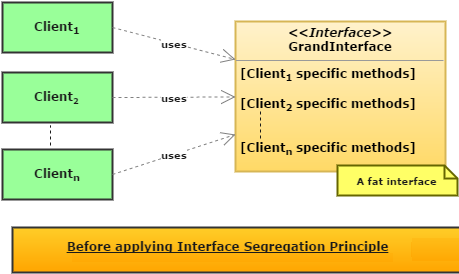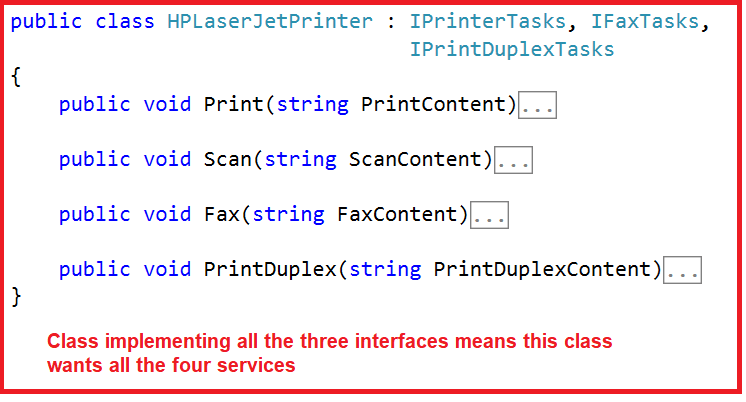
- #INTERFACE SEGREGATION PRINCIPLE HOW TO#
- #INTERFACE SEGREGATION PRINCIPLE SOFTWARE#
- #INTERFACE SEGREGATION PRINCIPLE CODE#
- #INTERFACE SEGREGATION PRINCIPLE SERIES#
Let us define an interface to violates ISP that contains code.Ĭreate ICompanyDepartment Interface that contains only the company departments. The Interface Segregation Principle states that clients should not be forced to implement interfaces they don't use. This rule also includes modules and functions. This means that an interface that creates a small will do only a unique job, larger interfaces should be split into smaller ones. I: Interface segregation principle D: Dependency inversion principle S: Single-responsibility principle According to the single-responsibility principle, a class should be responsible for only one activity and only have one cause to change.
#INTERFACE SEGREGATION PRINCIPLE SOFTWARE#
I strivefor articles that are prag- Sidebar: Unied Notation 0.8 matic and directly useful tothe software engineer in thetrenches. It states that clients should not be forced to. Interface Segregation Principle (ISP) states that: Clients should not be forced to depend on methods they do not use. The Interface SegregationPrinciple This is the fourth of my Engineering Notebook columns for The C++ Reportthat appear in this column focus on the use of C++ and OOD, and address issues of soft-ware engineering. Each role interface declares one or more methods for specific behavior. The Interface Segregation Principle (ISP) is one of the five SOLID principles of object-oriented design. This principle says that Clients should not be forced to depend upon interfaces that they do not use. The Interface Segregation Principle advocates segregating a fat interface into smaller and highly cohesive interfaces, known as role interfaces.
#INTERFACE SEGREGATION PRINCIPLE HOW TO#
It shows the name and status of the user.We will be discussing the Interface Segregation Principle also known as ISP, as one of the SOLID principles of object-oriented programming and how to implement it when designing our software. and it derives its name from the diagram shown in image below. Thus clients, instead of implementing an interface implements only those role interfaces whose methods are relevant. The Interface Segregation Principle (ISP) says: 'No client should be forced to depend on methods it does not use'.

Let’s assume that in our application we have the following view: The Interface Segregation Principle suggests segregating an interface into smaller and highly cohesive interfaces, known as role interfaces and each role interface declares one or more methods for specific behavior. Martin, states that clients should not be forced to implement interfaces they do not use. In other words, it’s better to have more but smaller interfaces than one large one. The Interface Segregation Principle, introduced by Robert C.

Today we will be dealing with the Interface Segregation Principle ? Interface Segregation PrincipleĪs you can see in the picture – customers should not be forced to rely on interfaces that they do not use.
#INTERFACE SEGREGATION PRINCIPLE CODE#
It is a set of rules thanks to which we can write code that will be easier for us to scale, and change the behavior of our application, without moving the code of a large part of the app.


One possible solution would be to rework our model into interfaces that take into account the engine-less state of our Car.
#INTERFACE SEGREGATION PRINCIPLE SERIES#
This is the fourth article in the series on the acronym SOLID. This is a blatant violation of Liskov substitution and is a bit harder to fix than our previous two principles.


 0 kommentar(er)
0 kommentar(er)
